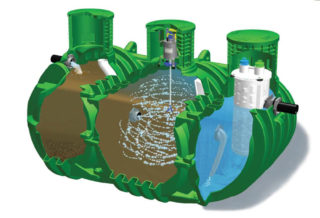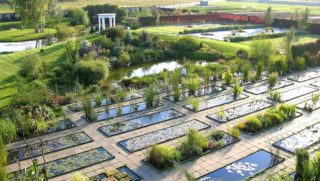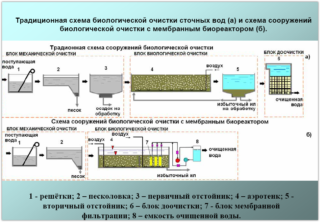Modern man uses a large amount of water for his own needs. In the process of its use, the liquid is exposed to serious pollution, becoming a threat to the environment and people. Therefore, thorough processing must be carried out before its removal into natural conditions. One of the stages of this process is biological treatment.
Biological treatment concept

This is a complex of ongoing works that are aimed at removing contaminants (mainly organic) from the water with the help of bacteria. Sewer drains from houses are filled with organic matter in the form of fats, sulfates, various types of tissues, carbohydrates and others.
Once in the sewer system, the effluent is corroded by bacteria. The final product is carbon dioxide and activated sludge, which settles to the bottom of the sewer well. It can then be used as an organic soil additive, making it rich in plant-beneficial substances. Sludge accumulates at the bottom of the tanks for several years, therefore, filling the tanks with itself, it reduces the volume of the sewer well. Therefore, the walls of structures must be cleaned from silt deposits.
Biological treatment scheme
There are two options for using bacteria: an independent process and with the use of measures that are based on mechanical, physicochemical and disinfecting operations.
The first option is to backfill dry bacteria inside the sewer wells, which come to life in the water, begin to multiply and eat organic matter. These drugs are sold in the form of tablets, powders and granules.
- Mechanical cleaning precedes the process of biological action. At this stage, sewage is subjected to mechanical separation of contaminated water into liquid and impurities of different fractions. For this, meshes, sieves, filters, sedimentation tanks, sand traps and other devices are used. They are usually installed in series. At this stage, the water is purified up to 40%.
- Physicochemical treatment is used to remove dissolved impurities from water. At this stage, such technologies as flotation, electrolysis, sorption, neutralization and others are used. Many of them use chemical reagents.
- Disinfection of sewage is the final stage. Most often, ultraviolet radiation is used for this, with the help of which harmful bacteria, viruses and other microorganisms are killed. Previously, chlorine was used for this, which today is not used in modern purification plants.
In the sewer systems of private houses, ultraviolet disinfection is rarely used. Although modern septic tanks of an expensive class carry such compartments in themselves. Standard septic sewer networks are three biological treatment options:
- aerotanks, which use activated sludge, rich in bacteria that devour organic matter;
- biofilters;
- anaerobic fermentation, which is called digestion.
The former are considered the most effective. The principle of operation of such biological wastewater treatment plants is based on the design of the equipment. Purely structurally, these are several containers combined into one device. In one, the sedimentation of undissolved particles occurs - the water is clarified.In the second, the effluent is exposed to activated sludge. This is where biological treatment takes place. In the third wastewater, together with the sludge, they are supplied by a pump, where the sedimentation of the sludge masses occurs. They subsequently fall back into the second compartment by gravity.
Some septic tanks have a fourth compartment, where water is purified using oxygen, because some kind of bacteria can only live if it is available. Such equipment is supplied with compressors.
Biofilters are popular among summer residents because they are designed to treat a small amount of sewage. Basically, this is a container into which bacteria are loaded. Manufacturers offer two types of biofilters:
- drip;
- two-stage.
The former differ from the latter only in a reduced cleaning speed. In terms of quality, the two technologies are the same.
Digester tanks are a reinforced concrete container with a floating lid, which can be lifted under the pressure of the evolved methane gas. The latter is a waste product of bacteria. Sewage drains inside the tank are heated using water or steam radiators. Inside there is a mixer that rotates all the time, mixing the contents of the digester.
There is no oxygen inside the container. It is these conditions that make it possible to isolate fatty acids from the organic mash, which float to the surface of the water mass. Here they are converted by bacteria into methane, carbon dioxide and silt. The latter is deposited at the bottom of the tenk. Gases are discharged outside the equipment through special pipes in the equipment cover.
Biological ponds

This type of biological sewage treatment is used if it is necessary to combine an entire village or several large houses into one system. There are three types of schemes:
- A small river is brought into the pond, the water of which is mixed with sewage. Precipitation of heavy undissolved particles occurs. Cleaning time is at least 15 days. Usually, fish are bred in such ponds, which increase the degree of biological treatment.
- Several ponds into which the effluent enters undiluted. The reservoirs are located in series. Water moves from one pond to another. Thus, the degree of water pollution is reduced. In such reservoirs, carp are often bred.
- Pretreatment reservoirs. This is the final stage of a multi-stage cleaning, not associated with ponds and other reservoirs of this type.
In private housing construction, complex technological processes are practically not used. The most difficult of them is a septic tank that works on the principle of an aeration tank. These are compact, volatile devices that are mounted next to the foundation of the house. There are simple modifications without the use of electricity. In them, biological cleaning processes take place with the help of bacteria, which are poured directly into the septic tank. The former are several times more expensive than the latter, but they have a very high degree of purification - up to 99%.
Water from such treatment facilities can be used to water the garden and vegetable garden. If additional filter elements are installed, the clarified liquid can be used for domestic needs.









